
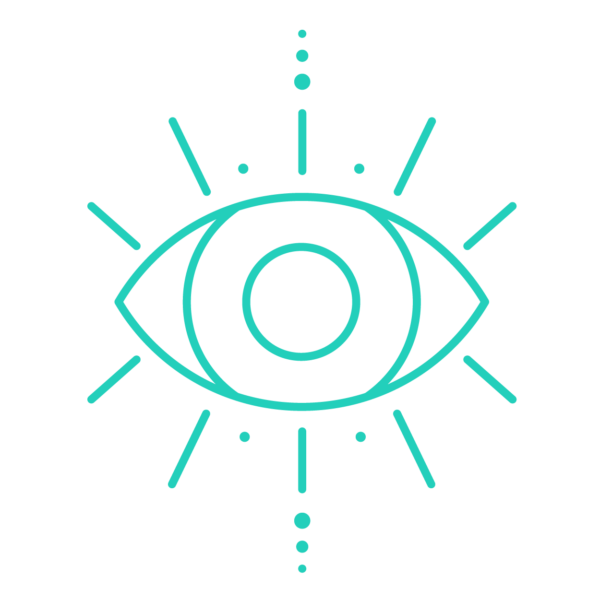

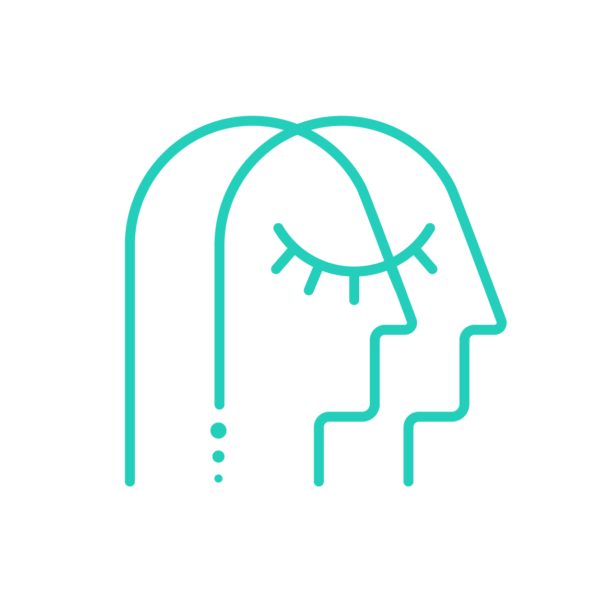

Every time a brain cell fires, there is an accompanying electrical impulse, which is what we identify as a brainwave. These individual impulses are far too small to be read by any standard equipment.
However, because our brain is composed of hundreds of thousands of neurons firing hundreds of times per second and in communication with each other, we can pick up any organized patterns that emerge.
Essentially, when neurons fire in synchrony, they create bursts of electrical activity. These symphonies of neuronal firing are read by sensors placed on the scalp.
Because there is so much electrical activity happening at any particular moment, the signal we receive is a bit on the messy side. It’s messy because it’s essentially a collection of everything occurring at any particular moment in one region.
This pattern is called the raw EEG and its signal looks something like this:
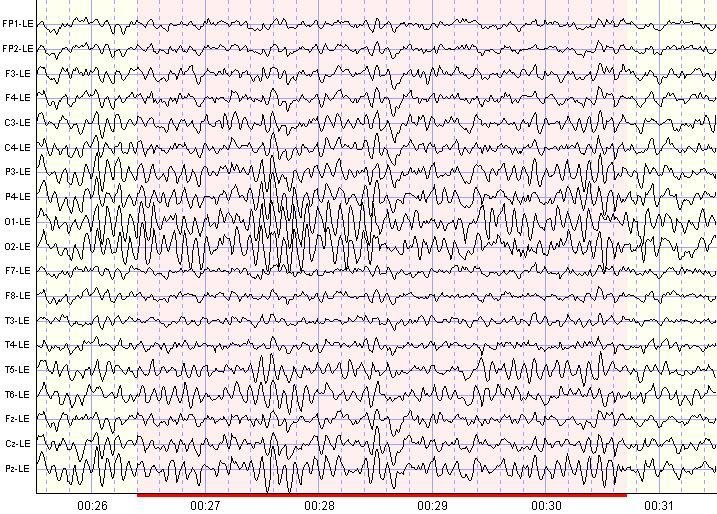
The image above is a screen capture of a 19 channel EEG signal. Essentially, this recording is examining 19 locations on the scalp simultaneously.
This is what we see on the scanners in the background of medical TV shows and what most people imagine when they think of brainwaves. However, this group of squiggly lines doesn’t mean much unless you are a neurologist or an EEG technician!
These squiggly lines are very useful in a hospital setting when looking for gross abnormalities such as a seizure.
However, if we are wanting to look at more subtle changes in consciousness, the raw signal leaves much to be desired.
Lucky for us, techniques have been developed to take a raw EEG recording, like the one above, and filter it, allowing us to see all of the different frequencies contained within each of those 19 channels.
This deserves a bit of an explanation:
Brainwaves, just like any electrical signal can be described in terms of their frequency and amplitude.
Frequency refers to how many repetitions there are of the wave within a second of time, usually referred to as cycles per second (cps) and reported as hertz (hz).
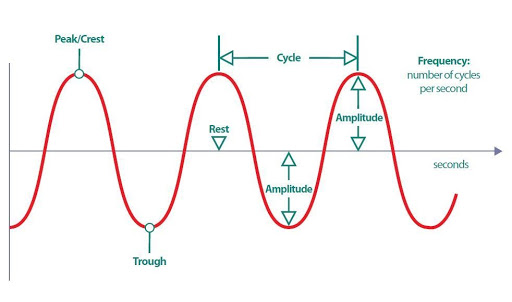
If the image above represents one second of time and there are two cycles occurring (each peak to peak is considered one cycle), we would describe this as 2 hz activity.
At any given moment the brain is producing frequencies from as slow as you can measure (below 1 hz) to an unknown speed (we are still trying to figure this out).
However, the vast majority of brainwaves occur between 1 and 50 hz.
Consequently, brainwaves in this range are nearly always the focus of brainwave analyses.
The other dimension of electrical activity that is important to understand relates to power. If speed is measured in hertz and relates to how many repetitions occur in a second of time, power is measured in microvolts and measures how big the waveform is.
It is essentially a calculation of the average peak to trough of the electrical signal.
On the “brainwave metrics” diagram the vertical (y) axis displays the range of power.
In non-hospital settings, the EEG sample is processed through a mathematical formula (fast Fourier transform; FFT) that separates the various frequencies within the raw signal and averages the power of each frequency, giving you a concrete measurement of “how much” activity is happening at different frequencies.
At any given moment, at any point on the surface of the brain, you will find electrical activity of every frequency we can measure, from the very slow (1-2 hz) to the very fast (100 hz). That is a bit overwhelming to consider and is typically simplified by creating clusters of frequencies that many people have at least heard of, including delta, theta, alpha, and beta.
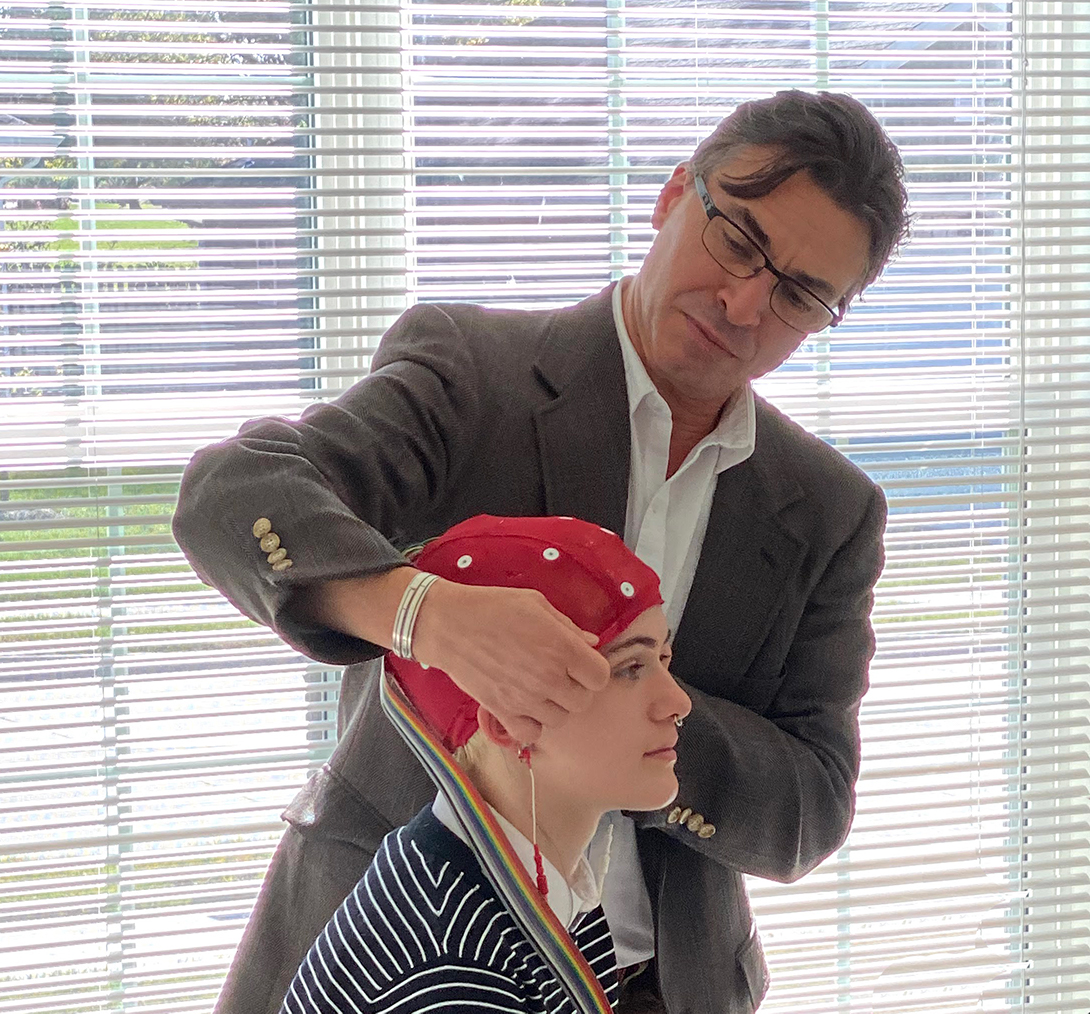
Brainwave bands are simply clusters of frequencies that are lumped together based loosely on their shape and function. Different researchers, neurofeedback companies, and clinicians define these EEG bands slightly differently. The BrainLink Lite headband, used with Healium, uses the following categories:
Delta (0.5 – 2.75Hz)
Theta (3.5 – 6.75Hz)
Low-Alpha (7.5 – 9.25Hz)
High-Alpha (10 – 11.75Hz)
Low-Beta (13 – 16.75Hz)
High-Beta (18 – 29.75Hz)
Low-Gamma (31 – 39.75Hz)
Mid-Gamma (41 – 49.75Hz)
Delta waves (0.5 – 2.5 hz) are the slowest brainwaves. When they are dominant, the person in question is probably unconscious.
Just to be clear, we always have delta activity, but when it increases significantly, it will be very difficult (if not impossible) to maintain any sort of alert consciousness.
When this frequency is dominant, the brain is involved in resting and regeneration.
Think about what is happening during deep sleep. You might also see heightened delta activity in areas of the brain that have been damaged in some way. Again, it is the brain’s way of shutting things down for repair.
Theta waves (3.5 – 6.75 hz) are obviously a bit faster than delta, but still very slow.
These brainwaves tend to increase while retrieving certain types of memories, in moments of creativity, and during the “twilight state” that we experience just before falling asleep.
Theta waves are often associated with the subconscious.
As such, this is generally the place that people shift toward during a hypnotic state; a state that is more open, creative, and suggestible. This also happens to be the dominant frequency for young children.
Low Alpha waves (7.5 – 9.25 hz) are even a bit faster than Theta waves, but still are considered on the slow side.
When used in this way, “low alpha” refers to the frequency range rather than the amplitude of the waves. To minimize confusion, this band is sometimes referred to as Alpha1.
Alpha is like our neutral; our idling speed.
Low Alpha is generally associated with being relaxed and internally focused. For this reason, it is generally associated with states of meditation, similar to Transcendental Meditation or Zen.
High Alpha waves (10-11.75 Hz) are often referred to as Alpha2 and are associated with a mental state of open awareness or quiet readiness.
This implies being capable of responding to a wide range of changes in the environment. In peak performance training, this state is associated with fast reflexes and accurate responses.
This state may be a component of being in “the zone” or a flow state.
Low Beta waves (13-16.75 Hz) are observed in the sensorimotor cortex, and they are also referred to as the sensorimotor rhythm (SMR) and are connected to reduced attention to sensory input and decreased motor activity.
It can be thought of as mentally alert without action or “reflecting before acting.”
When this pattern is observed in other areas of the brain it is referred to as Low Beta or Beta1. This band often increases during problem-solving.
High Beta waves (18 – 29.75 Hz) are often elevated during anxiety, worry, or rumination or in connection with emotional intensity. This band can also increase during productive cognitive engagement, or working too hard (over-efforting).
Low-Gamma (31 – 39.75Hz) are sometimes considered another range of High Beta rather than Gamma. These frequencies often demonstrate high amplitudes in persons who are worried or ruminating or feel “stressed out,” or hyper-vigilant.
Mid-Gamma (41 – 49.75Hz) represent a range of brain waves that are obviously very fast. They are generally at the top of the range that you will see in any research or brain training.
Increases in Mid-Gamma waves are associated with a very sharp focus and feelings of creativity, insight, and being energized. Bursts of this frequency are often seen during high-level information processing or when various parts of the brain are working together to integrate information.
Unlike beta forms of processing, Mid-Gamma activation is often associated with a more effortless, easy form of understanding, such as we might see during an “aha” moment; effortless insight.
Hopefully, you can begin to see how and why the fluctuations in different brain waves can often tell us something about the person’s state of consciousness AND how certain patterns–if they become rigid and inflexible, can be related to certain concerns.
For instance, too much theta without accompanying beta often suggests a brain that is underactivated. This is a brain that may have difficulties doing its job efficiently or effectively. If this pattern shows up in the frontal lobes, the person might have difficulty inhibiting their impulses, sustaining attention, or successfully utilizing their working memory. This pattern (excessive Theta/Beta) is the stereotypical ADHD brainwave pattern. On the other hand, a brain that consistently has large amounts of High Beta or Low-Gamma activity, particularly when it is not needed, may show signs of anxiety, agitation, or sleep problems. This is an overactivated brain; one that is hyperaroused.
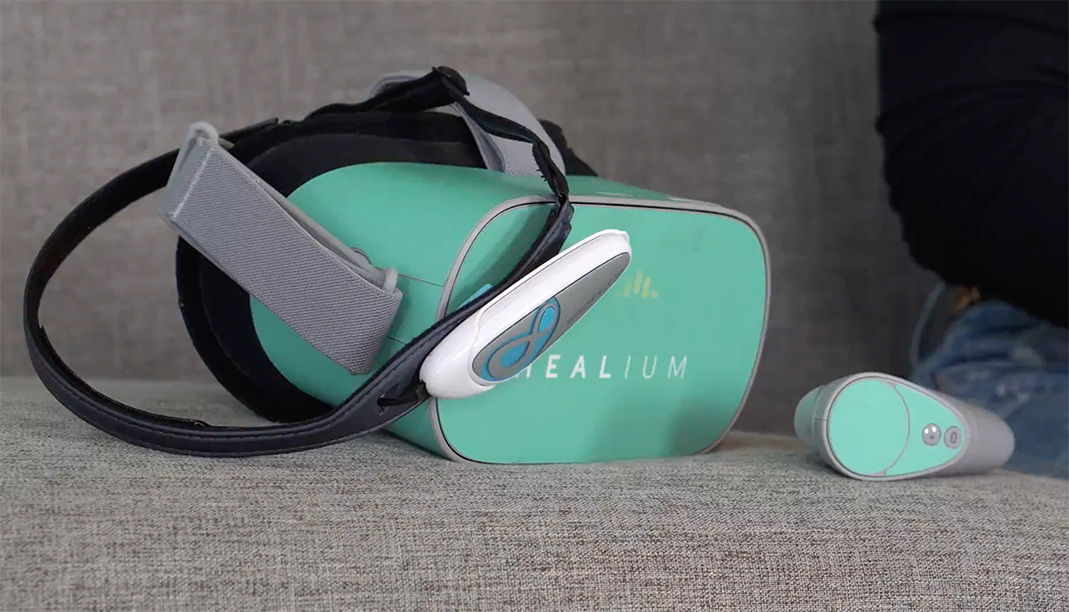
Healium currently utilizes a protocol to help you train for a focused calm brainwave states. Luckily, you won’t need a full EEG cap to use your brainwaves with Healium. You’ll only need a BrainLink Lite EEG headband and a pro subscription to Healium.
The EEG patterns most associated with stress and anxiety are increased fast-wave activity (High Beta/Low-Gamma) and decreased slow-wave activity (Alpha; Price and Budzynski, 2009).
Not surprisingly, neurofeedback strategies designed to reduce stress and anxiety have focused on decreasing these specific patterns. Sometimes this is done by rewarding slower brainwave patterns (alpha; Moore, 2000; Hammond, 2005 a and b), and other times it is accomplished by simply rewarding decreases in High Beta/Low-Gamma activity, which is the approach taken in Healium.
Research has consistently shown that excessive slow activity (Theta and/or Low Alpha) in frontal and/or central regions of the brain is associated with cognitive slowing, inattention, and lack of alertness. Specifically, this pattern is usually examined as a ratio of slow to fast waves (Theta/Low Beta). If a high ratio is considered potentially problematic, a low ratio is often sought for times of focus or peak mental performance.
Using the BrainLink Lite EEG headband can give you access to your brainwave data in a super simplified way. While it’s not diagnostic and only meant for self-awareness, when combined with Healium’s app, you’ll be able to see how your brainwaves fit into the brainwave bands by reviewing your data dashboard.
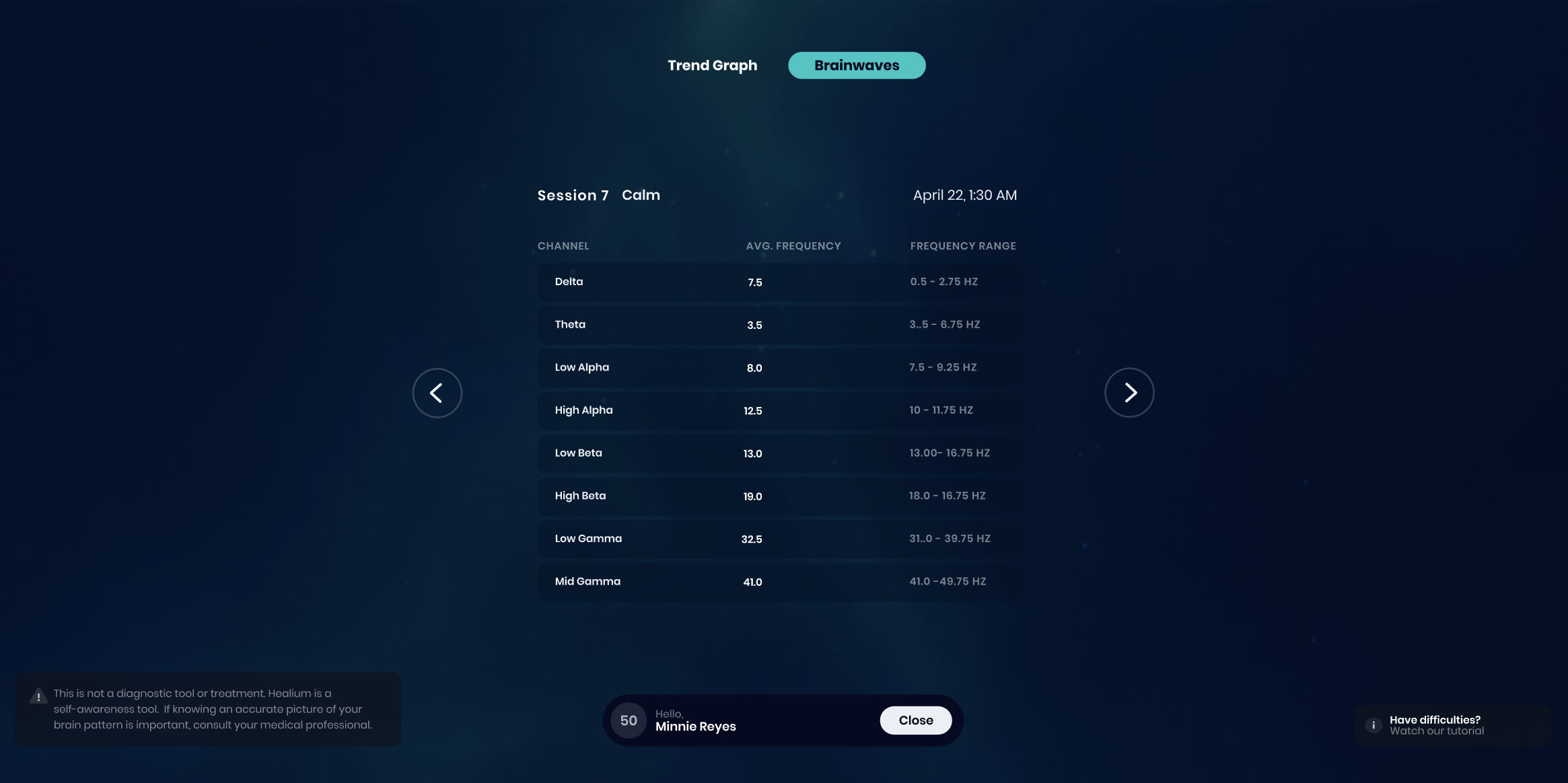
Neurofeedback is a powerful tool. Use it to improve your sleep, increase your focus, calm your mind, and rewire your thinking to reduce ruminating thoughts. Your thoughts have power.
*Reminder: Healium is not a diagnostic tool or a replacement for psychotropic medications.
When Healium VR is used with the BrainLink Lite EEG headband, you are measuring a flow state or a “focused calm”. Let’s take a deeper look at the algorithm, choosing the experiences, threshold settings, and instructions for users new to virtual reality as a wellness tool.
When you open the Healium app it asks you if you are using an EEG headband. If you select “Connect,” the software will connect to the headband using Bluetooth technology. Read these instructions for help connecting the BrainLink to your Oculus headset.
For the first 20 seconds, the system will collect EEG data without providing any feedback. It uses that baseline information to create a starting threshold. The exact calculations are done in the background of the app.
When you begin an experience, you’re able to see a representation of your EEG data in the form of a small moving ball of light (firefly) at the bottom of the screen. As you relax or become more engaged and alert, the firefly moves higher above the baseline. The height of the firefly indicates success in the protocol. As long as you remain above the threshold (solid line), you are being successful in shifting your baseline brainwave patterns in the desired direction.
When this happens, the VR experience progresses without interruption. If you happen to become stressed or unfocused during the experience, the firefly drops below the threshold and triggers a change in the form of dimming of the environment, a pause of the experience, or a red tint covering the experience. This is the feedback, helping you become more aware of your internal state.

As soon as you return to the desired state of consciousness, the firefly moves above the threshold line, and the experience proceeds without the “negative” feedback.
This approach is not usually recommended for acute stress reduction as it typically requires a bit of repetition to learn what internal states influence your brainwaves and the feedback. In addition, this training can take a variety of forms depending on which protocol is used, which experience is selected, how the feedback is displayed, and how the thresholds are set. I will discuss each of these below.
What happens when you engage in an activity that calms you but keeps your focus? You’re so entranced that time passes with no meaning. You’re alert but not overstimulated. Your thoughts come and go without worry. You feel peaceful with yourself. We call this feeling “flow”.
Getting into a flow state is important for high performers, starting a task that requires a lot of focus, or developing creative thoughts. Flow occurs when you become more relaxed, reduce ruminating/worry, or excessive thinking. This can be particularly helpful as an adjunctive tool if you’re managing stress, reducing anxiety, or increasing your mental resilience.
Focused calm feelings can help those managing ADHD, depression, or cognitive difficulties. Use this protocol for a midday mental health break before returning to a work task or a project that needs your attention.
It’s important to remember that in these scenarios you might be engaging in a brain wave pattern that may feel challenging or unknown. With this in mind, the other elements of the experience become important considerations.

It’s common to start with experiences that are naturally relaxing and pleasing, such as Relaxing Beach, or Waterfall. These experiences provide soothing environments, gentle music, and easy guidance into a relaxed and pleasant emotional state.
Beginning with one of these experiences increases the likelihood of success when first starting with virtual reality meditation. This can be important as you get used to VR/AR, learn to recognize your increasingly subtle internal states, and develop the ability to connect your internal state to external feedback. Once you have achieved some basic skills, it may be helpful to switch to experiences that are less directive.
Several experiences offer a nature-based visual environment without music or verbal guidance. This requires you to enter the desired mental/emotional state with only minimal support. Once you have achieved success with this level, it can be helpful to introduce experiences that require you to change the environment from “negative” to “positive” through your success with the neurofeedback protocols. The Big Tree and Calm the Storm are good examples of this type of experience.
By default, the firefly is displayed at the bottom of the screen. This is a visual representation of your success. The higher the firefly is above the baseline, the “better” you’re doing at shifting your brainwave pattern.
While this is a useful image, it can also add some challenges. At first, you may find the presence of the firefly distracts you from the content of the experience, minimizing the impact. In addition, the presence of the firefly can create feelings of competition or a tendency to use mental effort to move the firefly.
In these cases, you’ll typically be less successful. Particularly for beginners, we recommend toggling the firefly “off” and simply using the dimmer or red tint feedback as an indication of success.
The firefly can be turned off by pointing your controller at the firefly and pressing the trigger button. It will also display as only a glowing orb if you want to remove the distraction of the trail and movement.
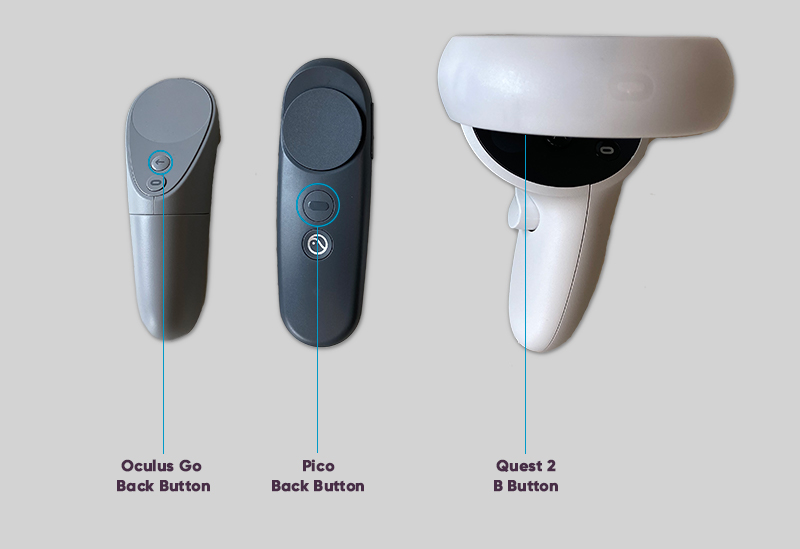
To change the dimmer tint, press the B Button (Oculus Quest 2) or the back button (Oculus Go, Pico) . This brings up a settings menu. Choosing between the dimmer or red tint feedback options is a personal preference. The dimmer may provide more subtle feedback but maybe frustrating as the screen becomes more difficult to see.
Healium calculates a starting threshold based on the first 20 seconds after the initial BrainLink headband connection. The assumption is that the baseline state represents our brainwave patterns in an average state without trying to relax or focus.
While the starting threshold often works just fine, it is sometimes necessary and important to adjust the threshold for personal preference or training needs. Point your controller at the firefly and click and hold the trigger to adjust the slider bar allowing you to make the threshold easier or harder.
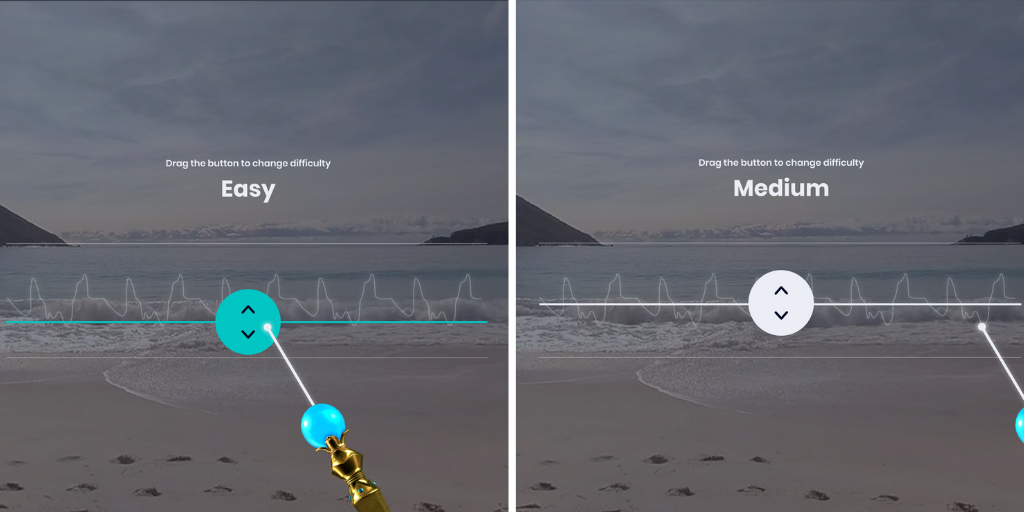
As you move the slider, you will see the threshold move up or down on the firefly graph. When first starting to use virtual reality technology or neurofeedback we suggest adjusting the threshold to make it relatively easy until you feel more comfortable.
However, if the threshold is regularly set “too easy” it is not actually providing any useful feedback. If you never see a change in the feedback, there is no way to connect it to your internal state. Once you feel comfortable with Healium, we suggest adjusting the threshold so that it is triggered by the firefly movement between 20 and 50% of the time.
 Again, some of this is a personal preference and individual variability. Some people learn better with minimal feedback while others need more. If the threshold is set “too difficult” and you are constantly receiving feedback, this is also not helpful and can create frustration.
Again, some of this is a personal preference and individual variability. Some people learn better with minimal feedback while others need more. If the threshold is set “too difficult” and you are constantly receiving feedback, this is also not helpful and can create frustration.

As soon as you are presented with any kind of information about your physiology and a goal, the tendency is to “do something” to make it change which results in over efforting.
You’ll do best with very gentle shifts in your attention. When using Healium you should aim to be “relaxed, but alert.” It can also be helpful to direct your attention to the content of the experience. For example, keep this in mind when beginning: “Let the experience guide you. Keep your attention on what you see and hear. Do your best to follow along with any instructions. When you find your attention shifting to other things, see if you can return to the experience.”
For the Calm experience, relax the muscles in your body, slow your breathing, and put a slight grin on your face. All of these instructions shift the nervous system into a more relaxed, parasympathetic state.
After your experience, it’s helpful to ask yourself, “what did I notice?” Of course, the question is really orienting toward your internal experience. If we can help you increase your awareness of your internal state, this leads to the greatest likelihood of change.
Want to know more about how long the effects of Healium last?
S. is a young adult client with some autoimmune concerns as well as some obsessive-compulsive tendencies. She would also have anxiety attacks that verged on panic several times a week, usually in response to something her roommates did that was upsetting to her.
When she began feeling agitated, things would tend to escalate quickly. On a scale from 1-10, she would typically rate her baseline level of agitation and anxiety at a 7.
During times of distress, this would quickly elevate to a 10. Much of our work related to helping her develop skills to manage these overwhelming feelings.
We used a variety of techniques including heart rate variability biofeedback, breathing exercises, mindful coloring, and using Healium.
When this client would become agitated in session, I would remind her of her skills and ask her to choose one that she thought might be helpful in that moment. Frequently she would choose Healium.
While this client was familiar with the software and experiences, at times I would also suggest experiences for her. For example, if she was ruminating about a particular fear or concern, I would recommend something a bit more engaging to draw her attention away from the repetitive thoughts.

Awake the Light or Dream Pool are good examples of this type of experience. At times I also suggested an experience she had not seen yet. The novelty of the experience could serve as a powerful distraction.
While S. was in the experience I would be observing her body language and watching for any signs that she was beginning to relax. This is usually evident in a change in posture, breathing, or even letting out a sigh.
When I would notice any of these cues, I would point it out to the client while they were still in the experience (e.g., “I wonder if you notice any changes in your body or your breath”). If she is unable to identify the changes, I would more actively point them out (e.g., “seems like your breathing has slowed down”).
As she started to relax, I would ask her to rate her current level of agitation (while still inside the VR goggles). If the level was still above baseline, I would then ask if she wanted to stay in Healium a bit longer. This process would continue until she was able to rate her agitation at the baseline level. In some cases, a single Healium experience was enough, other times she would do several experiences.
You can see from this example that Healium can be used as a tool to assist in distracting from unwanted thoughts/feelings, breaking the stress cycle, increasing self-awareness, and developing self-regulation skills.
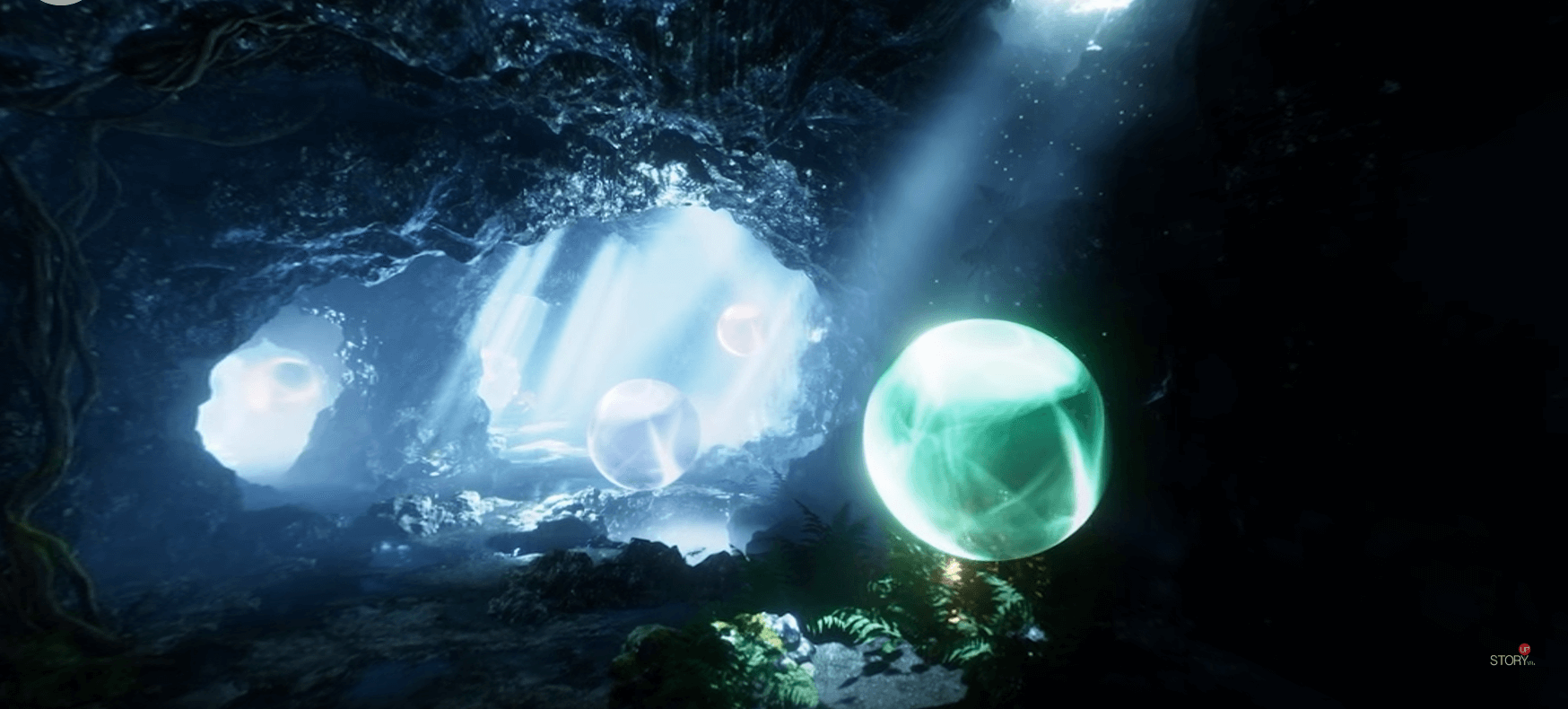
With some clients, the Healium experiences can be internalized such that they are able to reduce their agitation simply by imagining or remembering the VR experience.
In other cases, clients/students will purchase their own Healium VR kit, rent one from the therapist’s office, or download the Healium AR app for their phone.
While Healium is not designed to be a diagnostic tool or primary treatment intervention for any mental health concerns, it can be used as an adjunctive tool to assist in the reduction of stress. There are a few different ways to use Healium with clients and patients.
The Healium experiences have been created with content designed to quickly reduce both subjective and physiological feelings of stress.
Knowing that the brain believes what it sees, we have created experiences that transport the user to beautiful landscapes.
By removing visual and auditory cues associated with a stressful event and replacing it with peaceful and comforting scenes, the nervous system shifts almost instantaneously. In addition, our experiences provide the option of guided meditations to assist in directing the user into states of mindfulness, quiet mind, focus, or open-heartedness.
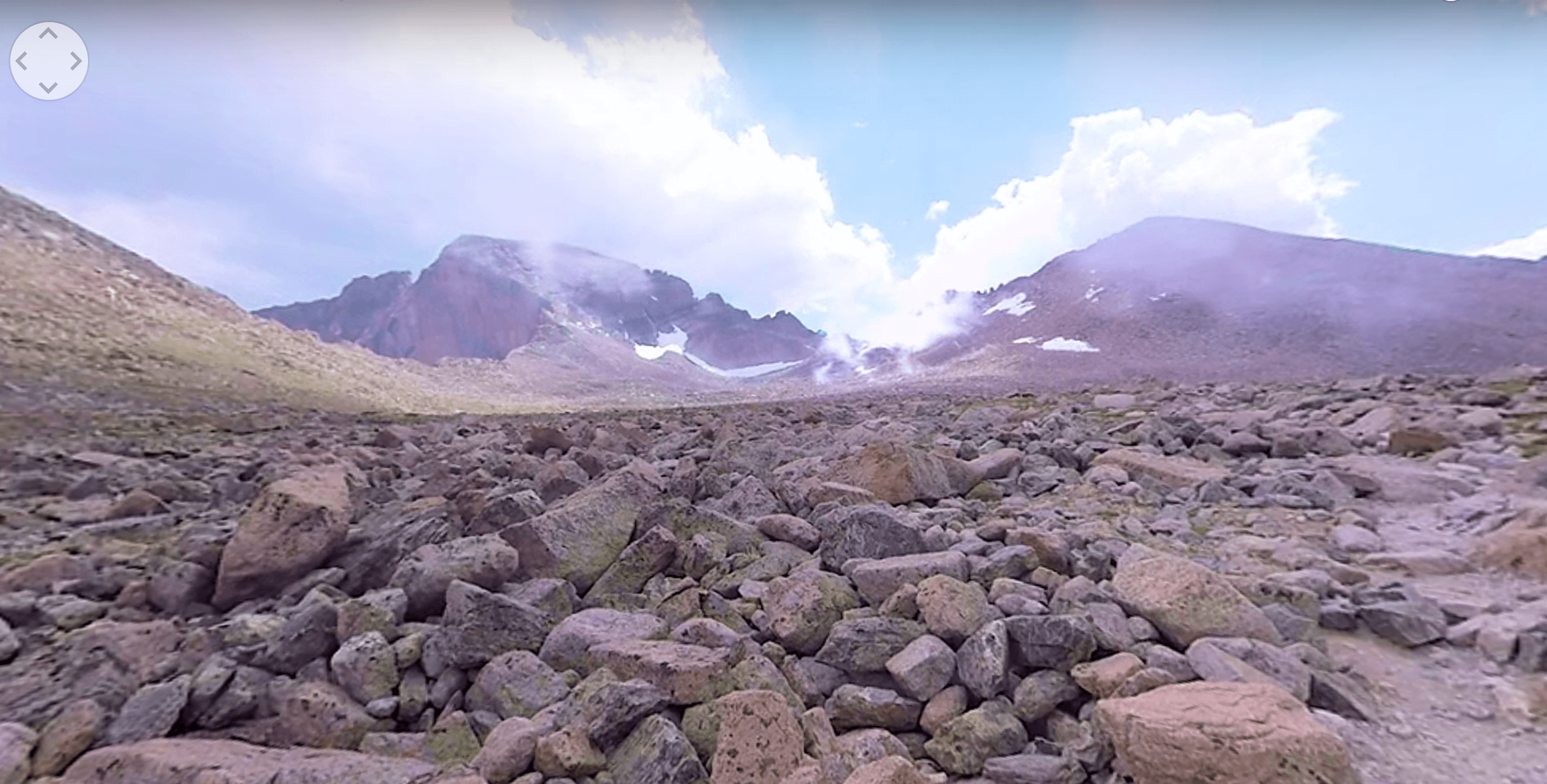
Consequently, this makes it a very effective tool to use before, during, or after a stressful event. Healium is currently being used in the following situations with this purpose in mind:
> Before surgery and childbirth
> During blood donations, and other minor surgical experiences
> After natural disasters (tornadoes, hurricanes)
In a school or mental health environment, Healium is used with students or clients to assist in managing states of agitation or anxiety that are interfering with their ability to be successful.
In school environments, it is being used in lieu of a “time out” or “quiet time” intervention. It is a way to provide a student a break if they become upset, or over-aroused.
The virtual reality goggles can be located in the classroom, the counselor’s office, or the principal’s office. If a student appears to be becoming agitated and they are not responding to other interventions, taking a Healium break may be enough for them to downshift and break the stress cycle.
Select students are also using Healium before tests as a way to encourage clear thinking and counteract test anxiety.
In therapists’ offices, Healium is being used in waiting areas for anxious clients prior to a therapy session. It is also being used in sessions to assist clients who begin experiencing high levels of anxiety or agitation during a session.
Essentially, it is being used as a self-management tool. In this context, we generally recommend using additional tools with Healium and/or gently coaching the client while inside the Healium experience.
This is a powerful intervention to help clients become more aware of subtle cues in their body related to states of stress versus balance.
For this use case scenario, I have generally introduced the virtual reality system and Healium software to the client in advance so it is not something they need to learn when distressed.
If they appear to be becoming increasingly agitated in the session, I will generally help them identify what is happening for them by asking about what they are noticing about their body, their breathing, their thoughts, etc.
If we have explored other self-soothing, emotion management techniques, I will encourage them to use one of those. If those techniques are not working and/or if they are too activated to use those skills in the moment, I will suggest using Healium for a few minutes.
In these situations, I do not use the EEG headband or Apple Watch, just the experiences themselves. If they have a favorite experience, I might suggest that or direct them toward experiences that may be most calming (again, it is generally a good idea to have explored this earlier with a client so you know their preferences).
In some cases, you may want something very simple and easy, such as a forest scene. In other cases, you may need something a bit more active, such as a guided mindfulness exercise, a breath pacer, or an experience that is more dynamic-with more scene changes and movement. This all depends on your client and their particular situation.
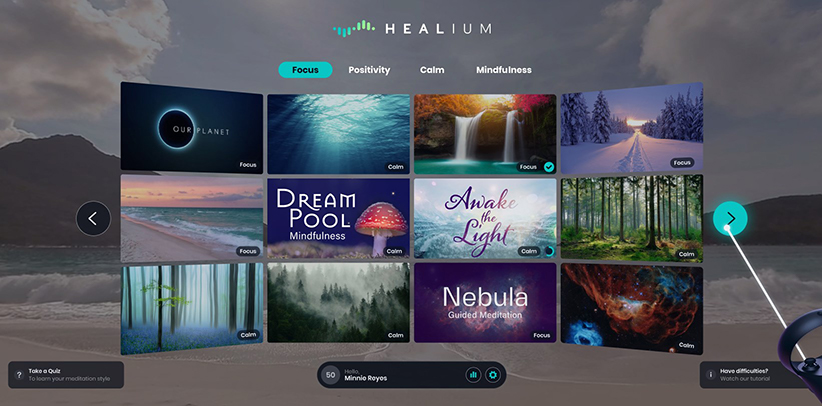
Healium virtual reality for Oculus Go has 30+ experiences within the app. They vary from nature-based to more abstract stories such as fractals and nebulas.
They are organized into different categories in order to help you and your client quickly and easily select the most appropriate experience.
Quiet Mind experiences will tend to be more calming and soothing with minimal scene changes and minimal instruction.
Mindfulness experiences are generally nature-based and will include some additional guided meditation scripts, actively drawing their attention to their experience of the scene and its impact on their internal state.
Open Heart experiences will include guidance related to activating feelings associated with appreciation or gratitude.
Focus experiences will tend to be more engaging with direction to attend not specific elements of the scene while reducing mind wandering.
*see appendix for a description of each experience